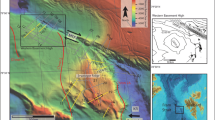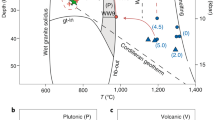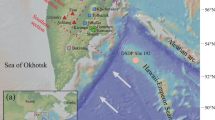Abstract
When mountain belts form, crustal rocks undergo metamorphism, resulting in the breakdown of volatile-bearing minerals and the release of water-rich fluids. As these fluids move towards the Earth’s surface, they can cause generation of ore deposits, enhance deformation of the crust and change rock composition1. Generation of such fluids has long been considered to occur dominantly during heating associated with burial of rocks. In contrast, the exhumation of rocks that follows heating has not been expected to generate large amounts of fluid1,2,3. Here we use mineral-equilibria modelling to show that the erosion-induced exhumation of greywacke — a common rock type in mountain-forming regions — generates a continual supply of new fluid. Fluid formation is particularly pronounced at temperatures below about 500 ∘C. Such fluids can explain the pairing of seismic and electrical conductivity anomalies observed in the Southern Alps in New Zealand, as well as the formation of vein-infilled backshears there.
This is a preview of subscription content, access via your institution
Access options
Subscribe to this journal
Receive 12 print issues and online access
$259.00 per year
only $21.58 per issue
Buy this article
- Purchase on Springer Link
- Instant access to full article PDF
Prices may be subject to local taxes which are calculated during checkout




Similar content being viewed by others
References
Fyfe, W. S., Price, N. J. & Thompson, A. B. Fluids in the Earth’s Crust (Elsevier, 1978).
Walther, J. V. & Orville, P. M. Volatile production and transport in regional metamorphism. Contrib. Mineral. Petrol. 79, 252–257 (1982).
Connolly, J. A. D. Devolatilization-generated fluid pressure and deformation-propagated fluid flow during prograde regional metamorphism. J. Geophys. Res. 102, 18149–18173 (1997).
Yardley, B., Gleeson, S. B. & Banks, D. Origin of retrograde fluids in metamorphic rocks. J. Geochem. Explor. 69–70, 281–285 (2000).
Stüwe, K. Tectonic constraints on the timing relationships of metamorphism, fluid production and gold-bearing quartz vein emplacement. Ore Geol. Rev. 13, 219–228 (1998).
Guiraud, M., Powell, R. & Rebay, G. H2O in metamorphism and unexpected behaviour in the preservation of metamorphic mineral assemblages. J. Metamorphic Geol. 19, 445–454 (2001).
Ring, U., Brandon, M. T., Willett, S. D. & Lister, G. S. in Exhumation Processes: Normal Faulting, Ductile Flow and Erosion (eds Ring, U., Brandon, M. T., Lister, G. S. & Willet, S. D.) 1–27 (Geol. Soc., London, Spec. Publ., Vol. 154, 1999).
Norris, R. J., Koons, P. O. & Cooper, A. F. The obliquely-convergent plate boundary in the South Island of New Zealand: implications for ancient collision zones. J. Struct. Geol. 12, 715–725 (1990).
Walcott, R. I. Modes of oblique compression: Late Cenozoic tectonics of the South Island of New Zealand. Rev. Geophys. 36, 1–26 (1998).
Stern, T. et al. in A Continental Plate Boundary: Tectonics at South Island, New Zealand (eds Okaya, D., Stern, T. & Davey, F.) 207–233 (Geophys. Monograph Ser., Vol. 175, American Geophysical Union, 2007).
Stern, T., Kleffmann, S., Okaya, D., Scherwath, M. & Bannister, S. Low seismic wave-speeds and enhanced fluid pressure beneath the Southern Alps, New Zealand. Geology 29, 679–682 (2001).
Wannamaker, P. E. et al. Fluid generation and pathways beneath an active compressional orogen, the New Zealand Southern Alps, inferred from magnetotelluric data. J. Geophys. Res. 107, 2117 (2002).
Jiracek, G. R., Gonzalez, V. M., Caldwell, T. G., Wannamaker, P. E. & Kilb, D. in A Continental Plate Boundary: Tectonics at South Island, New Zealand (eds Okaya, D., Stern, T. & Davey, F.) 347–369 (Geophys. Monograph Ser., Vol. 175, American Geophysical Union, 2007).
Batt, G. E. & Braun, J. On the thermomechanical evolution of compressional orogens. Geophys. J. Int. 128, 364–382 (1997).
Batt, G. E. & Braun, J. The tectonic evolution of the Southern Alps, New Zealand: Insights from fully thermally coupled dynamical modelling. Geophys. J. Int. 136, 403–420 (1999).
Vry, J. K., Powell, R. & Williams, J. Establishing the P–T path for Alpine Schist, Southern Alps near Hokitika, New Zealand. J. Metamorph. Geol. 26, 81–97 (2007).
Little, T. A., Cox, S., Vry, J. K. & Batt, G. Variations in exhumation level and uplift rate along the oblique-slip Alpine Fault, central Southern Alps, New Zealand. Geol. Soc. Am. Bull. 117, 707–723 (2005).
Powell, R., Will, T. M. & Phillips, G. N. Metamorphism in Archaean greenstone belts: calculated fluid compositions and implications for gold mineralisation. J. Metamorph. Geol. 9, 141–150 (1991).
Stauffer, D. & Aharony, A. Introduction to Percolation Theory 2nd edn (Taylor Francis, 1992).
Yardley, B. W. D. & Graham, J. T. The origins of salinity in metamorphic fluids. Geofluids 1, 1–8 (2002).
Vry, J. & McHaffie, K. Garnet growth during uplift and mylonitisation along the Alpine Fault bends, New Zealand: Fluid inclusion results. Geol. Soc. NZ Misc. Publ. 95A, 162 (1997).
Smith, M. P. & Yardley, B. W. D. Fluid evolution during metamorphism of the Otago Schist, New Zealand: (I) Evidence from fluid inclusions. J. Metamorph. Geol. 17, 173–186 (1999).
Craw, D. Fluid evolution, fluid immiscibility and gold deposition during Cretaceous-Recent tectonics and uplift of the Otago and Alpine Schist, New Zealand. Chem. Geol. 98, 221–236 (1992).
Sibson, R. H. & Scott, J. Stress/fault controls on the containment and release of overpressured fluids: Examples from gold-quartz vein systems in Juneau, Alaska; Victoria, Australia and Otago, New Zealand. Ore Geol. Rev. 13, 293–306 (1998).
Bailey, R. C. Trapping of aqueous fluids in the deep crust. Geophys. Res. Lett. 17, 1129–1132 (1990).
Etheridge, M. A., Wall, V. J., Cox, S. F. & Vernon, R. H. High fluid pressure during regional metamorphism and deformation: Implications for mass transport and deformation mechanisms. J. Geophys. Res. 89, 4344–4358 (1984).
Tullis, J., Yund, R. & Farver, J. Deformation-enhanced fluid distribution in feldspar aggregates and implications for ductile shear zones. Geology 24, 63–66 (1996).
Kodaira, S. et al. High pore fluid pressure may cause silent slip in the Nankai Trough. Science 304, 1295–1298 (2004).
Powell, R. & Holland, T. J. B. An internally consistent dataset with uncertainties and correlations: 3, applications to geobarometry, worked examples and a computer program. J. Metamorph. Geol. 6, 173–204 (1988).
Holland, T. J. B. & Powell, R. An internally consistent thermodynamic data set for phases of petrological interest. J. Metamorphic Geol. 16, 309–343 (1998).
Acknowledgements
This project owes its start to results from the South Island GeopHysical Transect (SIGHT) programme (with financial support from NSF programmes EAR-9418530, EAR-98530 and EAR-9725883 and the New Zealand Foundation for Research Science and Technology). The authors gratefully acknowledge support from the following sources: J.V., Victoria University (grants 23065, 25773, 23117) and The University of Melbourne; R.P., the Australian Research Council (ARC) grant DP0451770; K.M.G., the US National Science Foundation (NSF) (grants DAS-0222171, DMS-0537015); and K.P., NSF grant DMS-0537015 and the NSF Research Experiences for Undergraduates (REU) programme through VIGRE grant DMS-0091675. Supplementary Fig. S1 was kindly provided by S. Cox, GNS Science, Dunedin. The manuscript has been improved based on thoughtful reviews by A. Tomkins.
Author information
Authors and Affiliations
Contributions
J.V. identified the problem as being of interest. The final calculation and design of Figs 3, 4 and Supplementary Fig. S2 was done by R.P. with input and data provided by J.V., and J.V. and R.P. contributed equally to the writing of the letter. K.M.G. and K.P. undertook early calculations that were instrumental in bringing the Letter to its present focus, and contributed insights and feedback during the writing process.
Corresponding author
Ethics declarations
Competing interests
The authors declare no competing financial interests.
Supplementary information
Supplementary Information
Supplementary Information (PDF 763 kb)
Rights and permissions
About this article
Cite this article
Vry, J., Powell, R., Golden, K. et al. The role of exhumation in metamorphic dehydration and fluid production. Nature Geosci 3, 31–35 (2010). https://doi.org/10.1038/ngeo699
Received:
Accepted:
Published:
Issue Date:
DOI: https://doi.org/10.1038/ngeo699
This article is cited by
-
Deformation behavior and fluid action of quartz veins in the Xuelongshan metamorphic complex, Western Yunnan
Science China Earth Sciences (2023)
-
Orogenic gold: is a genetic association with magmatism realistic?
Mineralium Deposita (2023)
-
Formation of orogenic gold deposits by progressive movement of a fault-fracture mesh through the upper crustal brittle-ductile transition zone
Scientific Reports (2022)
-
Chemical and boron isotope composition of tourmaline from the Kiaka orogenic gold deposit (Burkina Faso, West African Craton) as a proxy for ore-forming processes
Mineralium Deposita (2022)
-
Syn-metamorphic sulfidation of the Gamsberg zinc deposit, South Africa
Mineralogy and Petrology (2021)



